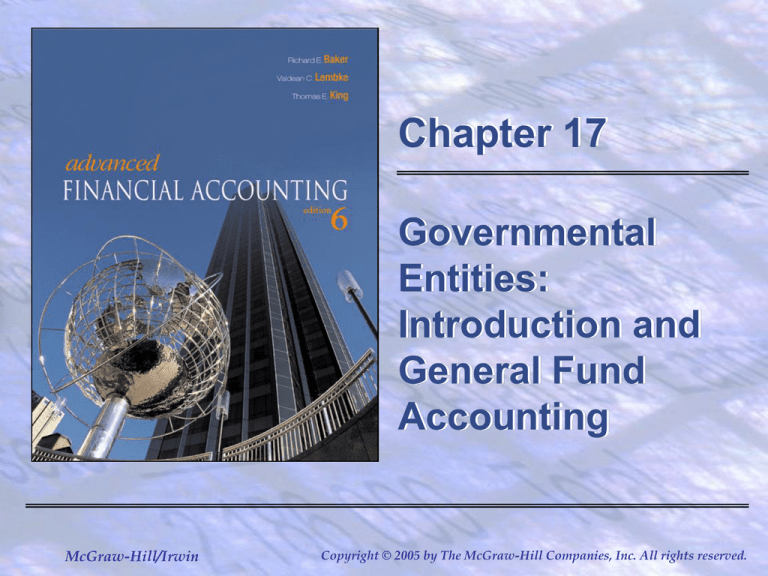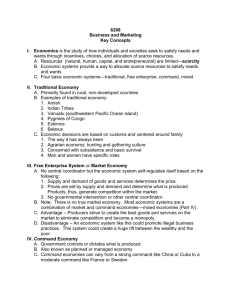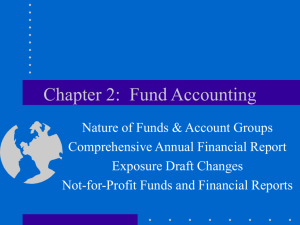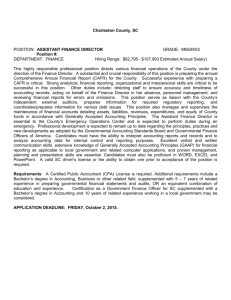
Chapter 17
Governmental
Entities:
Introduction and
General Fund
Accounting
McGraw-Hill/Irwin
Copyright © 2005 by The McGraw-Hill Companies, Inc. All rights reserved.
Governmental Entities
• In the early 2000s, the combined annual
spending of federal, state, and local
governments exceed $3.5 trillion.
• Governmental purchases of goods and
services constitute approximately 20
percent of the total gross national product
of the United States.
17-2
Governmental Entities
• Each of the 50 states follows relatively uniform
accounting standards; however, some states
have unique statutory provisions for selected
items.
• Local governments are political subdivisions of
state government.
17-3
Governmental Entities
• The 80,000 local governmental units in the
United States are classified as:
• General-purpose local government,
such as counties, cities towns, villages,
and townships.
• Special-purpose local government,
such as soil conservation districts.
• Authorities and agencies, such as the
New York Port Authority and local
housing authorities.
17-4
Governmental Entities
• Authorities and agencies differ from other
governmental units because they typically
do not have taxing power and may sell only
revenue bonds, not general obligation bonds.
17-5
Governmental Entities
• Governmental entities have operating
objectives different from those of commercial
entities; therefore, governmental accounting
is different from accounting for commercial
enterprises.
• The major differences between governmental
and for-profit entities are specified in the next
seven slides.
17-6
Governmental Entities
• Governmental accounting must recognize that
governmental units collect resources and collect
expenditures to fulfill social needs.
• Society expects governmental units to develop
and maintain an infrastructure of highways,
streets, and sewer and sanitation systems as
well as to provide public protection, recreation,
and cultural services.
17-7
Governmental Entities
• Except for some proprietary activities such as
utilities, governmental entities do not have a
general profit motive.
• Police and fire departments do not have a profit
motive; instead these units must be evaluated
on their abilities to provide for society’s needs.
17-8
Governmental Entities
• Governmental operations have legal
authorization for their existence, conduct
revenue raising through the power of taxation,
and have mandated expenditures they must
make to provide their services.
• The governmental accounting system must
make it possible to determine and demonstrate
compliance with laws, regulations, grant
restrictions, bond indentures, and a variety of
other legal constraints.
17-9
Governmental Entities
• Governmental entities use comprehensive
budgetary accounting, which serves as a
significant control mechanism and provides
the basis for comparing actual operations
against budgeted amounts.
• The budget is a legally established statutory
control vehicle.
17-10
Governmental Entities
• The primary emphasis in governmental fund
accounting is to measure and report on
management’s stewardship of the financial
resources committed to the objectives of the
governmental unit.
• Accountability for the flow of financial resources
is a chief objective of governmental accounting.
The managers of the governmental unit must be
able to show they are in compliance with the
many legal regulations governing its operations.
17-11
Governmental Entities
• Governmental entities typically are required to
establish separate funds to carry them out their
various missions.
• Each fund is an independent accounting and
fiscal entity and is responsible for using its own
resources to accomplish its specific
responsibilities.
17-12
Governmental Entities
• Many fund entities do not record fixed assets or
long-term debt in their funds.
• A separate record of the fixed assets and longterm debt is maintained within the governmental
unit.
17-13
Expendability of Resources versus
Capital Maintenance Objectives
• The major differences between commercial and
governmental accounting are due to the
objectives of the entities.
• In commercial enterprises, the emphasis is on
the measurement of the flow of all economic
resources of the firm. In contrast, the major
focus for many of the operations within the
governmental funds of a governmental entity is
the flow of current financial resources available
to provide services to the public.
17-14
Expendability of Resources versus
Capital Maintenance Objectives
• In commercial enterprises, the accrual basis of
accounting is used to match the revenues and
expenses during a period with the objective of
measuring profitability.
• The company’s balance sheet contains both
current and non-current assets and liabilities,
and the change in retained earnings reflects
the company’s ability to maintain its capital
investment.
17-15
Expendability of Resources versus
Capital Maintenance Objectives
• Operating authorization is initiated by a budget
that is passed by the legislative governing body.
• Managers of governmental units must be very
careful to ensure that resources are expended
in full and complete compliance with the legal
and financial restrictions placed upon the
governmental entity.
• The focus on expendability of resources affects
many of the accounting and financial reporting
standards of governmental entities.
17-16
GASB
• In 1984, the Financial Accounting Foundation
created a companion group to the Financial
Accounting Standards Board.
• The Governmental Accounting Standards Board
(GASB) is now responsible for maintaining and
developing accounting and reporting standards
for state and local governmental entities.
17-17
Fund Accounting
• Accounting for governmental units is given the
general description of fund accounting to
distinguish it from accounting for commercial
entities.
• Fund accounting reflects the unique aspects of
governmental operations.
17-18
Fund Accounting
• This chapter presents an overview of fund
accounting and illustrates accounting in the
general fund, typically the most important part
of most governmental units.
• Chapter 18 presents the accounting for the
remaining funds of a governmental entity and
the financial statements required of government
units.
17-19
Types of Funds
• Governmental units must provide a large range
of services, such as fire and police protection,
water and sewerage, legal courts, and
construction of public buildings and other
facilities.
• In addition, governmental units receive their
resources from many different sources and must
make expenditures in accordance with legal
restrictions.
17-20
Types of Funds
• To accomplish the objectives of the
governmental unit, the unit establishes
a variety of funds as fiscal and accounting
entities of the governmental unit.
• Different funds are established for the
specific functions that a government must
provide.
17-21
Types of Funds
• Most funds obtain resources from taxes on
property, income, or commercial sales; they
may also obtain resources as grants from
other governmental agencies, from fines or
licenses, and from charges for services.
• Each fund must make its expenditures in
accordance with its specified purposes. For
example, a fund established for fire protection
cannot be used to provide school buses for
the local school.
17-22
Types of Funds
• Each fund has its own asset and
liability accounts, and its own revenue
and expenditures accounts.
• The term expenditures refers to the
outflow of resources in funds providing
governmental services.
17-23
Types of Funds
• Separate fund-based financial statements
must be prepared for each fiscal period.
In this manner, governing bodies or other
interested parties may assess the financial
performance of the funds in the fulfillment
of the specific purposes for which they were
established.
17-24
Types of Funds
• Funds are separate fiscal and accounting
entities established to segregate, control,
and account for resource flows. Three types
of funds are used by governmental units:
– governmental funds, of which the general
fund is usually the most important
– Proprietary funds
– Fiduciary funds
17-25
Governmental Funds
• The following five governmental funds
are used to provide basic governmental
services to the public:
• General fund.
• Special revenue funds.
• Capital projects funds.
• Debt service funds.
• Permanent funds.
17-26
Governmental Funds
• The number of governmental funds maintained
by the governmental entity is based on the legal
and operating requirements of the governmental
entity.
• Only one general fund will be created by each
governmental entity, but more than one of each
of the other types of governmental funds may
be created based on the specific needs of the
entity. For example, some governmental entities
establish a separate capital projects fund for
each major capital project.
17-27
Governmental Funds
• General Fund:
– Accounts for all financial resources
except for those required to be
accounted for in another fund.
– Includes transactions for general
governmental services provided by
the executive, legislative, and judicial
operations of the governmental entity.
17-28
Governmental Funds
• Special Revenue Funds:
– Accounts for the proceeds of revenue
sources that are legally restricted for
specified purposes.
– Includes resources and expenditures for
operations such as public libraries when
a separate tax is levied for their support.
17-29
Governmental Funds
• Capital Projects Funds:
– Accounts for financial resources for the
acquisition or construction of major capital
projects that benefit many citizens, such as
parks and municipal buildings.
– This fund is in existence only during the
acquisition for construction of the facilities
and is closed once the project is completed.
17-30
Governmental Funds
• Debt Service Funds:
– Accounts for the accumulation of resources
for, and the payment of, general long-term
debt principal and interest.
– This fund is used for servicing the long-term
debt of the government.
17-31
Governmental Funds
• Permanent Funds:
– Accounts for resources that are legally
restricted such that only earnings, but
not principal, may be used in support
of governmental programs.
17-32
Proprietary Funds
• Some activities of a government unit, such as
operation of a municipal water system, are
similar to those of commercial enterprises.
• In turn, the objective of the governmental unit is
to recover its costs in these operations through
a system of user charges.
17-33
Proprietary Funds
• Accounting and reporting for a proprietary
fund is similar to accounting for a commercial
operation.
• The balance sheet of each proprietary fund
reports all assets, including long-term capital
assets, and reports all liabilities, including
long-term liabilities.
17-34
Proprietary Funds
• There are two types of proprietary funds
typically used by governmental entities:
– Enterprise Funds
– Internal Service Funds
17-35
Proprietary Funds
• Enterprise Funds:
– Accounts for operations of governmental units
that charge for services provided to the
general public.
– Includes those activities financed in a manner
similar to private business enterprises where
the intent of the governing body is to recover
the costs of providing goods or services to the
general public on a continuing basis through
user charges.
17-36
Proprietary Funds
• Enterprise Funds (Continued):
– Also includes those operations that the
governing body intends to operate at a profit.
– Examples include sports arenas, municipal
electric utilities, and municipal bus
companies.
17-37
Proprietary Funds
• Internal Service Funds:
– Accounts for the financing of goods or
services provided by one department or
agency to other departments or agencies of
the governmental unit.
– The services are usually provided on a costreimbursement basis and are offered only to
other governmental agencies, not the general
public. Examples are municipal motor vehicle
pools, city print shops, and central
purchasing operations.
17-38
Fiduciary Funds
• Four fiduciary funds are provided for a
governmental unit. Three are trust funds that
account for financial resources maintained in
trust by the government:
• Pension and Other Employee
Benefit Trust Funds.
• Investment Trust Funds.
• Private-Purpose Trust Funds.
17-39
Fiduciary Funds
• The fourth fiduciary fund, agency funds, is
used to account for resources held by the
government solely in a custodial capacity.
17-40
Fiduciary Funds
• Pension (and other employee benefit) Trust
Funds:
– Accounts for resources required to be held
in trust for the members and beneficiaries
of pension plans, other post-employment
benefit plans, or other employee benefit
plans.
17-41
Fiduciary Funds
• Investment Trust Funds:
– Accounts for the external portion of
investment pools reported by the
sponsoring government.
17-42
Fiduciary Funds
• Private-Purpose Trust Funds:
– Accounts for all other trust arrangements
under which the fund’s resources are to be
used to benefit specific individuals, private
organizations, or other governments, as
specified in the trust agreement.
17-43
Fiduciary Funds
• Agency Funds:
– Accounts for assets held by a government
unit in an agency capacity for employees or
for other governmental units.
– An example is the city employees’ payroll
withholding for health insurance premiums.
17-44
Permanent versus Private-Purpose
• Note that the permanent fund, which is a
governmental fund, includes resources that are
legally restricted, such that the principal must be
maintained by the governmental entity and only
the earnings from the fund’s resources may be
used to benefit the government’s programs for
all of its citizens. [Continued on next slide.]
17-45
Permanent versus Private-Purpose
• In contrast to the permanent fund, privatepurpose trust funds include trusts under which
the principal may or may not be expendable,
but for which the trust agreement specifies the
principal, if expendable, and the earnings, may
be used only for the benefit of specific
individuals, organizations, or other governments.
17-46
Reporting Entity
• The financial statements of a governmental
entity include the primary governmental unit,
such as a state government, a general-purpose
local government, or a special-purpose local
government that has a separately elected
governing body, and its component units for
which the primary governmental unit has
financial accountability. This is defined as the
reporting entity.
17-47
Reporting Entity
• A governmental unit may have a variety of
boards, commissions, authorities, or other
component units under its control.
• GASB 14 states that financial accountability
exists for these component units if the primary
government unit appoints a majority of an
organization’s governing body and is able to
impose its will on the organization or possesses
a financial benefit or assumes a financial burden
for the organization.
17-48
Reporting Entity
• The government reporting model, as established
by GASB 34, specifies that both fund financial
statements, and government-wide financial
statements, must be presented for most
governmental units.
• Some funds, such as the general fund, use the
modified accrual basis of accounting to
recognize revenue and expenditure
transactions.
17-49
Reporting Entity
• Furthermore, no long-term capital assets, or
general long-term debt, are recorded in the
general fund.
• However, a reconciliation schedule will be
required to go from the fund financial statements
to the government-wide financial statements.
17-50
Reporting Entity
• The government-wide financial statements use
the accrual basis of accounting and report all
capital assets and all long-term debt.
• Government-wide financial statements are
presented in Chapter 18 after the conclusion
of discussion on the remaining funds.
17-51
Measurement Focus and
Basis of Accounting (MFBA)
• The basis of accounting refers to the timing of
recognizing a transaction for financial reporting
purposes.
• For example, the cash basis recognizes revenue
or expenditures when cash is received or paid.
• In contrast, the accrual basis recognizes
revenue or expenditures when the transaction or
event takes place.
17-52
MFBA
• The modified accrual basis is a hybrid system
that includes some aspects of accrual
accounting and some aspects of cash-basis
accounting.
• The modified accrual basis is used in funds
that have a current financial resources
measurement focus.
17-53
MFBA
• The current resources measurement focus in on
the flow of current financial resources and the
proper expendability of the resources for
designated purposes and determination of the
available resources remaining to be expended.
• Expenditures recognized under the modified
accrual basis are the amounts that would
normally be liquidated with expendable available
financial resources.
• The five governmental funds have this focus.
17-54
MFBA
• The accrual basis method is used in funds that
have an flow of economic resources
measurement focus.
• This measurement focus is concerned with all
economic resources available to a fund during
a particular time period, thereby allowing for a
comparison of revenues and expenses and a
focus on maintenance of capital.
17-55
MFBA
• The proprietary funds and fiduciary funds
have this focus.
• In addition, as is presented in Chapter 18,
the government-wide financial statements
are based on the accrual basis method.
17-56
Budgetary Aspects
• Budgets are used in governmental accounting
to assist in management control and to provide
the legal authority to levy taxes, collect revenue,
and make expenditures in accordance with the
budget.
• Budgets establish the objectives and priorities
of governing units.
17-57
Operating Budgets
• Operating budgets specify expected revenue
from the various sources provided by law.
• The operating budget includes expected
expenditures for various line items, such as
payrolls of employees, supplies, and goods
and services to be obtained from outside the
governing unit.
• Operating budgets are used in the general
fund, special revenue funds, and sometimes
the debt service funds.
17-58
Capital Budgets
• A capital budget is prepared to provide
information about proposed construction
projects such as new buildings or street
projects.
• Capital budgets are used in the capital
projects funds.
17-59
Appropriation
• Approval of the budget provides the legal
authority to levy the local property taxes and to
appropriate resources for the expenditures. The
term appropriation is the legal description of the
authority to expend resources. The entry to
record general fund budget is as follows (all
amounts assumed):
Estimated Revenues Control $900,000
Appropriations Control
$850,000
Budgetary Fund
Balance – Unreserved
$50,000
17-60
Accounting for Expenditures
• The governmental funds use a variety of
controls over expenditures to ensure that
each expenditure is made in accordance
with any legal restrictions on the fund.
• For example, the encumbrances account
is a budgetary account this is reserving
part of the appropriation authority of the
budget. Encumbrances are a unique
element of governmental accounting.
17-61
Accounting for Expenditures
• To illustrate encumbrance accounting, assume
that on August 1, 20X1, Barb City completed a
purchase order for goods from an outside
vendor that are estimated to cost $15,000. The
entry to record this order for goods is as follows:
Encumbrances
$15,000
Budgetary Fund
Balance–Unreserved
for encumbrances
$15,000
17-62
Expenditure Transactions
• Governmental accounting places many
controls over expenditures, and much of
the financial reporting focuses on the
various aspects of an expenditure.
• Expenditures should be classified by fund,
function (or program), organizational unit,
activity, character, and principal classes of
objects.
17-63
Fund
• The fund is identified to show the specific source
of the expenditure. For example, the general
fund would be noted for expenditures from that
fund.
17-64
Function (or Program)
• Functions are group-related activities directed
at accomplishing a major service or regulatory
responsibility.
• Standard classifications of function include
general governmental; public safety; highway
and streets; sanitation, health and welfare;
culture and recreation; and education.
17-65
Organizational Unit
• Classifying by organization unit maintains
accountability by each unit director.
• The organization unit is determined by the
governmental unit’s organization chart.
• For example, public safety could be broken
down into police, fire, corrections, protective
inspection (such as plumbing and electrical
code inspections), and other protection (such
as flood control, traffic engineering, and
examination of licensed occupations).
17-66
Activity
• Activities within a function are recorded to
maintain a record of the efficiency of each
activity.
• For example, the police function could be
broken down into the following activities: police
administration, crime control and investigation,
traffic control, police training, support service
(such as communication services and
ambulance services), special detail services,
and police station and building maintenance.
Admittedly, each of these activities could be
broken down further, if desired.
17-67
Character
• Character classifications are based primarily on
the period the expenditures are anticipated to
benefit.
• Four major character classifications are current,
capital outlay, debt service, and
intergovernmental.
17-68
Object Class
• Object class is a grouping of types of items
purchased or services obtained. For example,
operating expenditures include personal
services, purchased and contractual services,
and commodities.
17-69
Object Class (Continued)
• Each of these objects could be further broken
down, depending on the information needs of
the governing entity. For example, purchased
services could include utility services, cleaning
services (such as custodial, lawn care, and
snow plowing), repair and maintenance
services, rentals, construction services, and
other purchased services, such as insurance
or printing.
17-70
Interfund Activities
• Interfund activities are resource flows between
fund entities.
• Interfund activities must be evaluated carefully
to ensure that the legal and budgetary controls
of the governmental unit are not violated.
17-71
Interfund Activities
• There are four types of interfund activities:
• Interfund loans.
• Interfund services provided and used.
• Interfund transfers.
• Interfund reimbursements.
17-72
Interfund Activities
• Outstanding interfund loans are presented as
receivable or payables on the fund’s balance
sheet information.
• Interfund services provided and used are
reported as part of the revenues and
expenditures on the operating statements.
17-73
Interfund Activities
• Interfund transfers are reported separately in
the other financing sources (uses) section of
the operating statement.
• Interfund reimbursements are not reported
on the fund’s financial statements.
17-74
You Will Survive This Chapter !!!!
• The fun continues in Chapter 18 !!!
• HINT: FUND ACCOUNTING
17-75
Chapter 17
End of Chapter
McGraw-Hill/Irwin
Copyright © 2005 by The McGraw-Hill Companies, Inc. All rights reserved.









